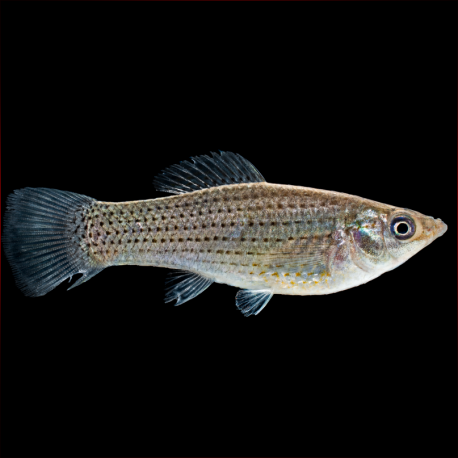More info
Datasheet
| Minimum Tank Size | 113 litres / 29.85 US gallons |
| Maximum Size | 7.6cm / 2.99inches |
| Temperament | Peaceful |
| Care Description | Moderate |
| Carbonate Hardness | 10-25 |
| pH | 7.0-7.8 |
General Description
The Balloon Molly, a hybrid variation of the Sailfin Molly (Poecilia latipinna), boasts an arched back, rounded large belly, and striking color variations including black, yellow, and white. Sporting a large, lyre-shaped caudal fin and an impressive dorsal fin, these fish demonstrate adaptability to various salt levels, thriving in either freshwater or saltwater aquariums with gradual acclimation.
Aquarium Suitability
With a preference for tanks of at least 30 gallons featuring robust plants like Java fern and Anubias, the Balloon Molly requires a good filtration system due to its hearty appetite. Its peaceful nature makes it a great fit for community tanks alongside other large, peaceful fish that share similar water conditions. Mollies exhibit aggression towards their young and other species' offspring, necessitating separation during breeding in a 25-gallon tank equipped with a spawning box.
Care and Hardiness
Moderate care level characterizes the Balloon Molly, which can adjust to a variety of salt levels and benefit from a teaspoon of aquarium salt per gallon in freshwater tanks. Regular feeding with algae-based flakes, freeze-dried bloodworms, tubifex, and brine shrimp is essential for their omnivorous diet.
Aquarium Setup
Maintaining a densely planted aquarium or a thick algae mat is vital for Balloon Mollies, with floating plants aiding in young fish rearing outside the breeding tank. Providing floating plants in a corner of the aquarium promotes successful reproduction, with females giving birth to 10-60 young every 60-70 days, already measuring about half an inch long.
Behavior
The Balloon Molly exhibits a peaceful temperament, making it suitable for community tanks. Males can be discerned by their pointed anal fin and larger dorsal fin, while females display a rounded anal fin and a distinctive pregnancy spot, showcasing sexual dimorphism in the species.
Feeding and Diet
Omnivorous in nature, the Balloon Molly requires a balanced diet of meaty foods and algae-based flakes. Offering a mix of freeze-dried bloodworms, tubifex, brine shrimp, and algae-based flakes ensures optimal health and nutrition for these fish.
Dimorphism and Captive Reproduction
Male and female Balloon Mollies can be distinguished by differences in their anal and dorsal fins. Females give birth to live young, emphasizing the livebearer nature of these fish. Setting up a breeding tank with dense plant cover is crucial for successful reproduction and the rearing of offspring outside the breeder tank.
Habitat and Distribution
The Balloon Molly originates from a hybrid lineage of Poecilia latipinna and is commonly found in freshwater and brackish habitats across various regions. Their adaptability to different salt levels has contributed to their widespread distribution in both aquatic environments.

